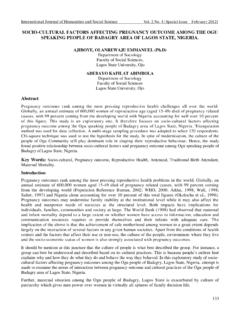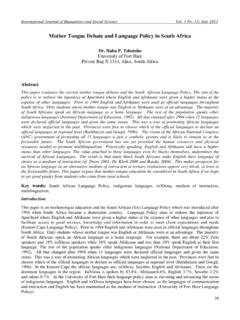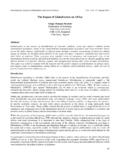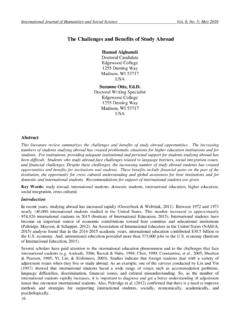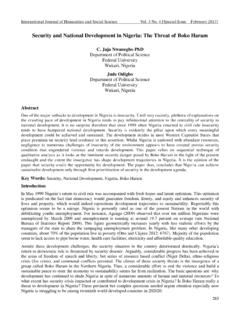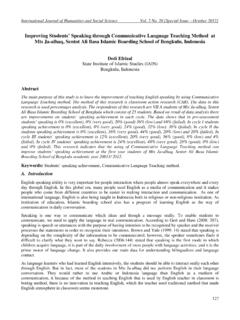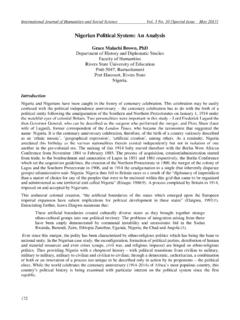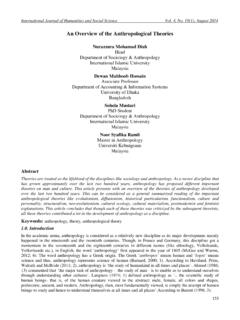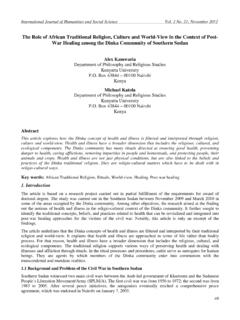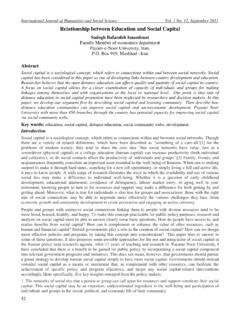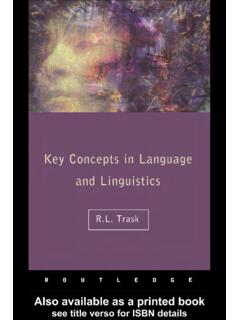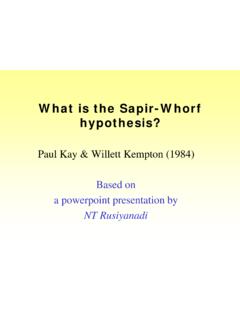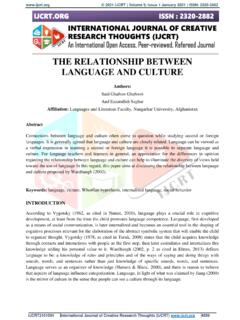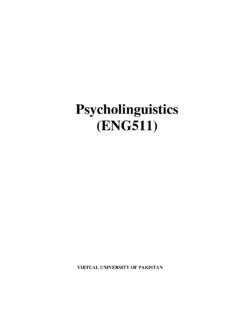Transcription of Language and Culture - ijhssnet.com
1 International Journal of Humanities and Social Science Vol. 2 No. 17; September 2012 230 Language and Culture Dr. Tengku Sepora Tengku Mahadi Associate Professor School of Languages, Literacies and Translation Universiti Sains Malaysia Malaysia Sepideh Moghaddas Jafari, PhD Student School of Languages, Literacies and Translation Universiti Sains Malaysia Malaysia Abstract Language , the most commonplace of all human possessions, is possibly the most complex and the most interesting. Since it is an instrument for humans' communications with each other, the growth and development of their talents, causing creativity, innovation, and novelty, exchanging and transferring their experiences, and on the whole, for formation of society(s).
2 Concern with Language is not new. From the earliest recorded history, there is evidence that people investigated Language . Many of the assumptions, theories and goals of modern linguistics find their origin in past centuries. However, this study aims to investigate whether there is any relationship between Language and Culture , and if so, what the relationship between Language and Culture is. To achieve the aims of this study, some of the main theories which can be related to the goal of the paper are introduced and explained. Then, it is followed by a precise discussion. The results of the article indicate that there is a very close relationship between Language and Culture .
3 That is, Culture has a direct effect on Language . Language and Culture are closely correlated. Introduction Human being is a social creature. In fact, man is a receiver and sender of messages who assembles and distributes information (Greimas, 1970). Sapir (1956) insists that every cultural pattern and every single act of social behaviour involves communication in either an explicit or implicit sense (p. 104).The tool for this communication is Language . This study seeks to investigate whether there is any relationship between Language and Culture , and if so, what the connection between Language and Culture is.
4 In other words, if there is relationship between Language and Culture , how they can have this association. To achieve the answer of the above question, some of the main relevant points are introduced and discussed as follows. Language To open discussion about Language , first of all, it seems necessary to mention that as far as Language is concerned, Saussure s theory of the sign is one of the main theories which had an effective and significant role in this domain. Saussure s theory of the sign has a thoughtful and reflective manipulate on both linguistic and the rise of semiotic approach. In this respect, Saussure (1974) believes that Language is a system of signs.
5 For him, a sign consists of a signifier (the sound- image or the written shape) and a signified (a concept), in the manner that, they both are inseparably linked with each other (ibid). In other words, the sound-image cannot be separated from the concept, that is to say, these two never part with each other (ibid). He further likens Language and thought to a sheet of paper; He believes that thought is the front part of paper and sound the back part. It is impossible to cut any of the two parts without cutting the other. In the sense that, in Language the sounds and thought are inseparable. Centre for Promoting Ideas, USA 231 On the other hand, the indivisibility and undividability of the signifier and the signified, for instance, for a speaker of English the sound-image dog belongs with the concept and perception dog and not with the concept cow, generates the misapprehension and false impression of the lucidity and clearness of Language .
6 In other words, as Hjelmslev (1969) maintains, It is the nature of Language to be overlooked (p. 5). Generally speaking, Language is introduced by Crystal (1971, 1992) as the systematic, conventional use of sounds, signs or written symbols in a human society for communication and self expression . Similarly, Emmitt and Pollock (1997) believe that Language is a system of arbitrary signs which is accepted by a group and society of users. It is taken delivery of a specific purpose in relation to the communal world of clients. Chase (1969) declares that the purpose of Language use is to communicate with others, to think, and to shape one s standpoint and outlook on life.
7 Indeed, Language figures human thoughts (ibid). Saussure (1956, 1972, 1974, 1983) defines Language as the system of differences. In this sense, he believes in the difference of meaning of a sound-image or written shape in different languages. If words stood for pre-existing concepts, they would all have exact equivalents in meaning from one Language to the next; but this is not true (Saussure, 1974, p. 116). That is to say, the concept of a sound-image or symbol in different languages is different. Culture According to Roohul-Amini (1989) " Culture has multifarious meanings.
8 Culture meant farming" (p. 15). It is used everywhere as rural Culture , urban Culture , American Culture and so on. Today, in every field, in humanities, every research requires a general view of Culture . It is used in archaeology, linguistics, history, psychology, sociology and etc. It is even said that man is an animal with Culture . That is to say, the factor which differentiates the human being's behaviour from the behaviour of animal is Culture (Mesbahe Yazdi, 2005). In general, from the sociological perspective, Culture is the total of the inherited and innate ideas, attitudes, beliefs, values, and knowledge, comprising or forming the shared foundations of social action.
9 Likewise, from the anthropological and ethnological senses, Culture encompasses the total range of activities and ideas of a specific group of people with common and shared traditions, which are conveyed, distributed, and highlighted by members of the group (Collins English Dictionary 1991, 1994, 1998, 2000, 2003). There are about two or three hundred and even more definitions for Culture . With respect to the definition of Culture , Edward Sapir (1956) says that Culture is a system of behaviours and modes that depend on unconsciousness. Rocher (1972, 2004), an anthropologist, believes that Culture is a connection of ideas and feelings accepted by the majority of people in a society (p.)
10 142). Undeniably, Culture is learned and shared within social groups and is conveyed by nongenetic ways (The American Heritage, Science Dictionary 2005). Taylor (1974), an anthropologist, says in his Primitive Culture that Culture in a complex definition includes beliefs, arts, skills, moralities, laws, traditions and behaviours that an individual, as a member of a society, gets from his own society. Kroeber and Kluckhohn (1952), consider civilization and Culture the same and they believe the two terms have been used synonymously. For them, they both indicate different levels of the same subject.
